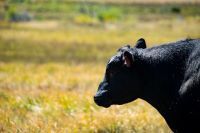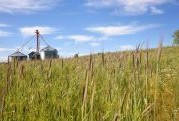
As we near the end of August, our state continues to experience extremely dry conditions. The drought has resulted in numerous county Secretarial Disaster Designations which results in producer eligibility for low interest emergency loans. Extended periods of time in D2 or D3 on the Drought Monitor have triggered eligibility in several counties for the Livestock Forage Program (LFP). Local county offices are accepting applications in LFP-eligible counties and continue to accept requests for emergency haying and grazing of CRP. In counties where LFP eligibility has reduced the CRP practices eligible for haying, producers are encouraged to explore the option of non-emergency haying and grazing. Non-emergency haying may offer opportunity for livestock producers to obtain much needed feed. Producers are encouraged to monitor the websites for CRP emergency haying and grazing and LFP eligibility.
Another FSA program that offers opportunity for compensation related to expenses incurred for hauling water to livestock due to an eligible drought is the Emergency Assistance for Livestock, Honeybees, and Farm-raised Fish (ELAP) Program. Livestock producers are encouraged to review the ELAP Fact Sheet and contact their local FSA office for additional details.
Unfortunately, cases related to the Delta Variant of COVID-19 are on the rise. As a result, our Minnesota service centers continue to operate with limited visitors, by appointment only. If you feel an in-person appointment is needed to conduct your business rather than by phone or online, please reach out to your local FSA office so they can assist in scheduling an appointment. As a reminder, all visitors and staff are required to wear a mask in a federal facility. Our local staff appreciate your efforts to protect them and their families. Your patience is appreciated as we continue to operate under COVID protocol.
I am hopeful the coming weeks bring much-needed precipitation to our drought-stricken counties. We realize these are challenging times for our producers. Do not hesitate to reach out to our local FSA staff for information on FSA programs and benefits you may be eligible for. Our employees are happy to assist and answer your questions.
Respectfully,
Michelle Page, Acting State Executive Director
|
If you’ve incurred additional operating costs for transporting water to livestock due to an eligible drought, assistance may be available to you through the Emergency Assistance for Livestock, Honeybees and Farm-Raised Fish Program (ELAP).
An eligible drought means that part or all of your county is designated D3 (extreme drought) or higher as indicated by the U.S. Drought Monitor.
Eligible livestock must be adult or non-adult dairy cattle, beef cattle, buffalo and beefalo, as well as alpacas, deer, elk, emus, equine, goats, llamas, reindeer, or sheep. Additionally, the livestock must have been owned 60 calendar days prior to the beginning of the drought and be physically located in the county designated as a disaster area due to drought. Adequate livestock watering systems or facilities must have existed before the drought occurred and producers are only eligible if they do not normally transport water to the livestock.
Livestock that were or would have been in a feedlot are not eligible for transporting water. ELAP covers the additional cost of transporting water and does not cover the cost of the water itself.
You must file a notice of loss on form CCC-851 the earlier of 30 calendar days of when the loss is apparent to you or by Jan. 31, 2022. Additionally, the deadline to submit an application for payment for 2020 ELAP assistance is Jan. 31, 2022.
You’ll have to provide documentation to FSA that shows the method used to transport the water, the number of gallons of water transported and the number of eligible livestock to which water was transported.
To make an appointment to sign up for ELAP and to learn more about eligibility, application and documentation requirements, contact your local County USDA Service Center or visit fsa.usda.gov.

For the 2021 and subsequent crop years, NAP forage producers with the intended use of grazing who elect to use independent assessments or other approved alternative loss percentage methods to establish their loss are no longer required to file a CCC-576 Notice of Loss with FSA. However, a CCC-576 Application for Payment form must be submitted to FSA no later than 60 calendar days after the coverage period ends.
Producers that elect to have the grazing loss determined using similar mechanically harvested units still must timely file a CCC-576 Notice of Loss within 15 days of the disaster event or damage to the crop first becomes apparent or within 15 days of harvest.
|
If you received a payment under the Wildfires and Hurricanes Indemnity Program+ (WHIP+) or the Quality Loss Adjustment Program (QLA) for crop production and/or quality losses occurring in 2018, 2019, or 2020 crop years, you are required to meet linkage requirements by obtaining federal crop insurance or Non-Insured Crop Disaster Assistance Program (NAP) coverage at the 60/100 level, or higher, for both the 2022 and 2023 crop years. When applying for WHIP+ or QLA, form FSA-895 (Crop Insurance and/or NAP Coverage Agreement) was submitted acknowledging the requirement to obtain federal crop insurance, if available, or NAP coverage if federal crop insurance is not available. The coverage requirement is applicable to the physical location county of the crop that received WHIP+ and/or QLA benefits.
Producers should not delay contacting their federal crop insurance agent or local county FSA Office to inquire about coverage options, as failure to obtain the applicable coverage by the sales/application closing date will result in the required refund of WHIP+ benefits received on the applicable crop, plus interest. You can determine if crops are eligible for federal crop insurance or NAP by visiting the RMA website.
|
Federal Crop Insurance Sales Closing Date: Application Closing Date
|
Crops
|
|
September 30
|
Forage Production and Grass Seed
Fall Seeded Small Grains (Rye)
|
|
November 20
|
Perennial Fruit (Apples, grapes, etc.)
|
|
March 15
|
Spring Planted crops (corn, soybeans, oats, Spring Wheat, annually planted mixed forage crops, etc.) where coverage is available.
|
|
NAP Application
Closing Date
|
Crops
|
|
September 1
|
Fall Seeded Small Grains
|
|
September 30
|
Value Loss Crops (Christmas Trees, ginseng, turfgrass sod, mushrooms, etc.)
Perennial Forage
Grass/legume Seed
Wild Rice
Asparagus, Rhubarb, Strawberries
|
|
November 20
|
Perennial Fruit Crops (apples, blueberries, cane berries, grapes, etc.)
|
|
December 31
|
Honey
Maple Sap
|
|
February 1
|
Onions
|
|
March 15
|
All other Spring planted/seeded crops not covered under federal crop insurance
|
For more information, contact your local County USDA Service Center or visit fsa.usda.gov.
University of Minnesota Extension is currently conducting a survey of Minnesota farmers to determine their farm safety and health needs. The 5-minute survey includes questions about pressing topic areas, the type of education needed, and current barriers to safety on farms. The results of this survey will help Extension prioritize work in farm safety and health. Minnesota farmers are asked to complete the 5-minute survey by August 31. The survey can be found online at z.umn.edu/FarmSafetySurvey. If you have any question or would like to complete the survey in a different format, please contact Emily Krekelberg at krek0033@umn.edu or 612-756-3977.

USDA’s Farm Service Agency (FSA) announced that organic producers and handlers can apply for USDA funds to assist with the cost of receiving and maintaining organic certification through the Organic Certification Cost Share Program (OCCSP). Applications for eligible certification expenses paid between Oct. 1, 2020, and Sept. 30, 2021, are due Nov. 1, 2021.
OCCSP provides cost-share assistance to producers and handlers of agricultural products for the costs of obtaining or maintaining organic certification under the USDA’s National Organic Program. Eligible producers include any certified producers or handlers who have paid organic certification fees to a USDA-accredited certifying agent. Producers can be reimbursed for expenses including application fees, inspection costs, fees related to equivalency agreement and arrangement requirements, travel expenses for inspectors, user fees, sales assessments and postage.
For 2021, OCCSP will reimburse 50 percent of a certified operation’s allowable certification costs, up to a maximum of $500 for each of the following categories or “scopes:”
- crops
- wild crops
- livestock
- processing/handling
- State organic program fees.
Organic farmers and ranchers may apply through an FSA county office or a participating state agency.
More Information
To learn more about organic certification cost share, please visit the OCCSP webpage, visit usda.gov/organic, or contact your local USDA Service Center.
|
Small nonfarm businesses in STATE may be eligible to apply for low‑interest federal disaster loans from the U.S. Small Business Administration. By law, SBA makes Economic Injury Disaster Loans available when the U.S. Secretary of Agriculture designates an agricultural disaster.
SBA eligibility covers both the economic impacts on businesses dependent on farmers and ranchers that have suffered agricultural production losses caused by the disaster and businesses directly impacted by the disaster.
Small nonfarm businesses, small agricultural cooperatives, small businesses engaged in aquaculture and most private nonprofit organizations of any size may qualify for Economic Injury Disaster Loans of up to $2 million to help meet financial obligations and operating expenses which could have been met had the disaster not occurred.
Eligibility for these loans is based on the financial impact of the disaster only and not on any actual property damage. These loans have an interest rate of 3 percent for businesses and 2 percent for private nonprofit organizations, a maximum term of 30 years and are available to small businesses and most private nonprofits without the financial ability to offset the adverse impact without hardship.
Businesses primarily engaged in farming or ranching are not eligible for SBA disaster assistance. Agricultural enterprises should contact the Farm Services Agency about the U.S. Department of Agriculture assistance made available by the Secretary’s declaration. However, nurseries are eligible for SBA disaster assistance in drought disasters.
Applicants may apply online, receive additional disaster assistance information and download applications at https://disasterloanassistance.sba.gov/. Applicants may also call SBA’s Customer Service Center at (800) 659-2955 or email disastercustomerservice@sba.gov for more information on SBA disaster assistance.

The Farm Service Agency (FSA) is accepting offers for specific conservation practices under the Conservation Reserve Program (CRP) Continuous Signup.
In exchange for a yearly rental payment, farmers enrolled in the program agree to remove environmentally sensitive land from agricultural production and to plant species that will improve environmental health and quality. The program’s long-term goal is to re-establish valuable land cover to improve water quality, prevent soil erosion, and reduce loss of wildlife habitat. Contracts for land enrolled in CRP are 10-15 years in length.
Under continuous CRP signup, environmentally sensitive land devoted to certain conservation practices can be enrolled in CRP at any time. Offers for continuous enrollment are not subject to competitive bidding during specific periods. Instead they are automatically accepted provided the land and producer meet certain eligibility requirements and the enrollment levels do not exceed the statutory cap.
For more information, including a list of acceptable practices, contact your local County USDA Service Center or visit fsa.usda.gov/crp.
|
The USDA Farm Service Agency’s (FSA) Direct Farm Ownership loans are a resource to help farmers and ranchers become owner-operators of family farms, improve and expand current operations, increase agricultural productivity, and assist with land tenure to save farmland for future generations.
There are three types of Direct Farm Ownership Loans: regular, down payment and joint financing. FSA also offers a Direct Farm Ownership Microloan option for smaller financial needs up to $50,000.
Direct Farm Ownership Loans can be used to construct, purchase or improve farm dwellings, service buildings or other facilities, and to make improvements essential to an operation.
Applicants must provide FSA with an estimate of the total cost of all planned development that completely describe the work, prior to loan approval and must show proof of sufficient funds to pay for the total cost of all planned development at or before loan closing. In some instances, applicants may be asked to provide certified plans, specifications or contract documents. The applicant cannot incur any debts for materials or labor or make any expenditures for development purposes prior to loan closing with the expectation of being reimbursed from FSA funds.
Construction and development work may be performed either by the contract method or the borrower method. Under the contract method, construction and development contractors perform work according to a written contract with the applicant or borrower. If applying for a direct loan to finance a construction project, the applicant must obtain a surety bond that guarantees both payment and performance in the amount of the construction contract from a construction contractor.
A surety bond is required when a contract exceeds $100,000. An authorized agency official determines that a surety bond appears advisable to protect the borrower against default of the contractor or a contract provides for partial payments in excess of the amount of 60 percent of the value of the work in place.
Under the borrower method, the applicant or borrower will perform the construction and development work. The borrower method may only be used when the authorized agency official determines, based on information from the applicant, that the applicant possesses or arranges to obtain the necessary skill and managerial ability to complete the work satisfactorily and that such work will not interfere with the applicant’s farming operation or work schedule.
Potential applicants should visit with FSA early in the initial project planning process to ensure environmental compliance.
For more eligibility requirements and information about FSA Loan programs, contact your local County USDA Service Center or visit fsa.usda.gov.
In order to claim a Farm Service Agency (FSA) payment on behalf of a deceased producer, all program conditions for the payment must have been met before the applicable producer’s date of death.
If a producer earned a FSA payment prior to his or her death, the following is the order of precedence for the representatives of the producer:
- administrator or executor of the estate
- the surviving spouse
- surviving sons and daughters, including adopted children
- surviving father and mother
- surviving brothers and sisters
- heirs of the deceased person who would be entitled to payment according to the State law
For FSA to release the payment, the legal representative of the deceased producer must file a form FSA-325 to claim the payment for themselves or an estate. The county office will verify that the application, contract, loan agreement, or other similar form requesting payment issuance, was signed by the applicable deadline by the deceased or a person legally authorized to act on their behalf at that time of application.
If the application, contract or loan agreement form was signed by someone other than the deceased participant, FSA will determine whether the person submitting the form has the legal authority to submit the form.
Payments will be issued to the respective representative’s name using the deceased program participant’s tax identification number. Payments made to representatives are subject to offset regulations for debts owed by the deceased.
FSA is not responsible for advising persons in obtaining legal advice on how to obtain program benefits that may be due to a participant who has died, disappeared or who has been declared incompetent.
Winter months in Minnesota can be long and cold, and for several years, farmers have faced propane storage shortages. FSA’s Farm Storage Facility Loan (FSFL) program provides funding for on-farm liquified petroleum tanks.
FSFL low-interest financing can be used to build or upgrade storage facilities and to purchase portable (new or used) structures, equipment, storage and handling trucks. Liquified petroleum tanks are covered for eligible commodities for the use of fuel for grain dryer equipment.
Loans up to $50,000 can be secured by a promissory note/security agreement, while loans exceeding $100,000 require additional security.
You do not need to demonstrate the lack of commercial credit availability to apply. The loans are designed to assist a diverse range of farming operations, including conventional operations, small and mid-sized businesses, new farmers, operations supplying local food and farmers markets, non-traditional farm products, and underserved producers.
To learn more about FSFLs and how these loans can help with your on-site propane tank storage needs, contact your local County USDA Service Center or visit fsa.usda.gov.
|